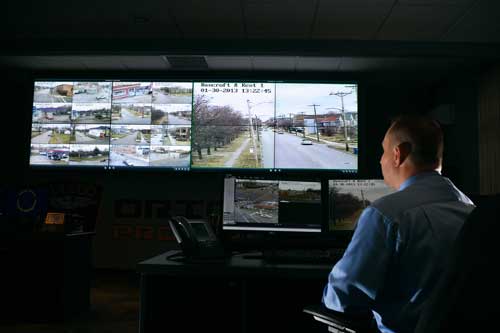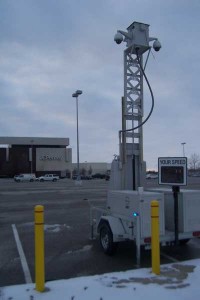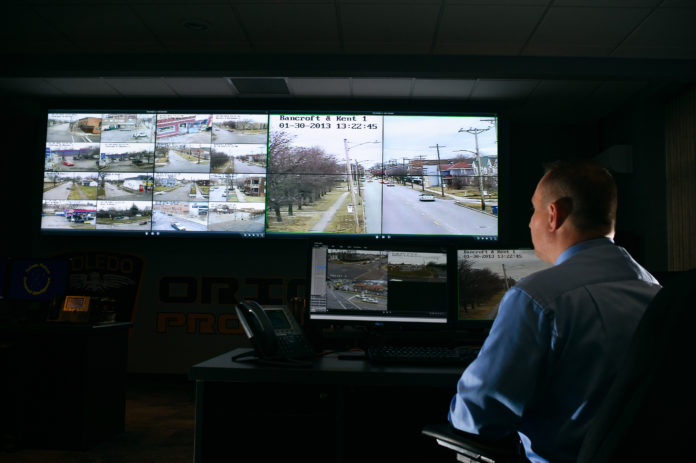A repeat bank robber was flabbergasted recently when police busted him on a Downtown Toledo sidewalk minutes after his latest heist.
The robber, disguised in clothes different from those he wore to the robbery, had no idea his getaway plan had been cracked by detectives. To solve the caper, the Toledo Police Department (TPD) used clues obtained from images recorded by crime cameras installed last year as part of the department’s Observation Research Intelligence Operations Network, known as Orion. Those cameras are the most visible aspect of Orion, launched by Chief Derrick Diggs as part of an overall data-driven policing strategy. The price tag for Orion was about $1.5 million, of which $820,000 was paid for out of the police department’s Law Enforcement Trust Fund, money obtained from assets seized from criminal enterprises.

Toledo Police Department Capt. Michael Troendle watches the monitors at Criminal Intelligence. Toledo Free Press Photo by Joseph Herr.
On Jan. 29, Toledo City Council approved a request by the police department for an additional $380,000 in capital improvement funds for the second phase of Orion. The additional funds are slated for the purchase and installation of advanced software to create a unified data warehouse and sweeping information network that will reach from the police cruisers on the streets to the entire department and even provide intelligence to surrounding law enforcement agencies, said Capt. Michael Troendle of the TPD Criminal Intelligence Section. Troendle estimates the total cost of phase two at $500,000, but noted that police still have $120,000 from the initial funding earmarked for software.
The idea is to build one major server that can be mined by police more efficiently, according to Troendle, a 20-year department veteran. The second phase of the Orion project will focus on creating a central system out of the disparate networks now accessed by police, including the NORIS criminal background database, 911 call center data, vehicle-mounted license plate readers and mobile data terminals. In addition, a number of internal databases, for example, gang activity, would be merged.
Troendle said the upgrades and improved computer networking will help his police analysts discover “hidden trends” in local crime. The improvements are also intended to bring a significant time-savings to the work of the Criminal Intelligence Section. Sgt. Scott Sterling, who works under Troendle, said the updated system could conceivably reduce a shift-long search of multiple databases to a single click of the mouse. The Criminal Intelligence Section currently employs four police officer analysts, one sergeant, and Troendle, who reports directly to Diggs. The unit was beefed up a year ago to meet the demands of bringing Orion online. But Troendle said his team, judging by industry standards, remains understaffed like the police department in general.
Fundamentally sound
City Councilman D. Michael Collins, who chairs the Public Safety, Law and Criminal Justice committee and voted in favor of the second phase of Orion funding, said the use of the cameras is a “fundamentally sound” concept, one that “certainly enhances the ability of a police department to function.” However, Collins stresses that the cameras will “never be a replacement for officers on the street.” And the councilman seemed to bristle at the “real time” label given by police to their camera monitoring operation, noting the cameras are only monitored during business hours and then only by one officer at a time during staggered one-hour shifts.
Troendle confirmed that monitoring schedule, explaining how his analysts are tasked with more than just watching TV. Those officers must also do a great amount of data entry to keep the computer files up to date, in effect justifying that “real time” label. It is difficult for someone to stare at video screens for a protracted time without a change of pace, Troendle said.
Still, all the cameras are recording all the time. The images are stored for 14 days before being erased, Troendle said. Any video that becomes evidence in a criminal matter will be stored “forever,” he said.
Besides monitoring images from the cameras, the Criminal Intelligence Section is responsible for generating crime analysis reports every two weeks. Those reports are given to the department’s watch commanders during biweekly briefings that typically last a couple of hours, said Public Information Officer Sgt. Joe Heffernan.
The data contained in those reports is intended to help commanders refine their patrols and deploy their resources efficiently.
“Random patrol doesn’t work,” said Troendle, who during his career also served four years on the department’s SWAT team. “When we were on SWAT, we were always looking for this [kind of] information,” he said.
Criminal Intelligence also issues four to five bulletins a week to all personnel and to neighboring law enforcement agencies. Troendle said Toledo police with Orion have created “unprecedented knowledge-sharing.”
Sky cops

A mobile trailer camera deployed near Westfield Shopping Center. Toledo Free Press Photo by Dave Willinger.
There are currently 73 cameras operating at 37 locations around the city, and nine more cameras in the process of being deployed. The computer-programmable cameras are remote-controlled from police headquarters, can swivel 360 degrees and have a 36x zoom. Some are equipped with infrared capability to “see” in the dark. In general, the cameras have been placed at crime hot spots, Troendle said, although some camera locations were selected with an eye toward protecting infrastructure.
The cameras, branded “sky cops” by the manufacturer, were purchased from Executive Security International (ESI), a Memphis, Tenn.,-based firm. Troendle had praise for the company despite what the captain called a “miscommunication” that has delayed the delivery of another component of Orion, namely, seven “gunshot cameras,” which come equipped with microphones that enable police to determine by triangulation the precise location of a shooter within seconds. Troendle expects to take delivery of those cameras in February. “The goal is to catch the guy shooting,” he said.
The TPD also has a pair of mobile sky cop units. Those trailer cameras were deployed near Westfield Franklin Park and along the Monroe Street corridor in West Toledo during the holiday season and were a big success, Troendle said.
The trailer cameras, easily identified by their flashing blue lights and police logo, deter car break-ins, car thefts and other crimes, he said.
Reducing crime?
Troendle took issue with detractors who claim the cameras do nothing more than displace crime, resulting in the bad guys committing their misdeeds in some other neighborhood where cops aren’t watching.
The police captain said the pole-mounted cameras are capable of being redeployed at any time to another location. But Troendle, who holds a master of science degree in criminal justice with a concentration in crime analysis from Tiffin University, was keen to explain that the number of crimes deterred by the cameras can be expected to be significantly greater than the number of any “displaced crimes” that may occur elsewhere.
And that results in a net reduction of crime, he said. The reasoning is that the factors which contribute to crime — a suitable target, a motivated offender and the lack of a suitable guardian are not equally distributed everywhere. Not every time a criminal is thwarted by the presence of police cameras is he going to find, and act on, some other unguarded target, Troendle said. He also emphasized that the benefits of deterrence typically extend beyond the actual area targeted by the cameras, constituting another multiplier of the technology’s effectiveness.
Burglaries, thefts down
Indeed, police spokesman Heffernan provided statistics he said confirm the efficacy of the cameras. Burglaries and thefts from cars were both down 22 percent last year compared to 2011, Heffernan said, with auto thefts down 5-percent. In raw numbers, those three types of crime saw a decrease year to year from 11,931 incidents in 2011 to 9,499 in 2012.
Heffernan credits the cameras and the overall data driven strategy being implemented by police for the reduction in those crimes. Statistics on the number of burglaries over the past four years, for example, show a significant reduction in 2012, the year Orion came online. Whereas there were 8,064 burglaries in 2009, 7,287 in 2010 and 8,366 in 2011, those crimes decreased to 6,490 last year, Heffernan said.
Data-driven policing means tracking crime series, tracking offenders and building predictive analysis models on the basis of computer software algorithms, Hefferman said. The intelligence is used to better deploy police resources.
The numbers are proof that data-driven strategy is having an impact, Heffernan said, doubly so because those reductions were achieved “with a record low number of manpower.”
Heffernan stressed that the system is still new and the police department is still fine-tuning it, even as more upgrades are coming in. For that reason he believes there will be even better results in the future. “I don’t think we’ve realized 100 percent of the benefits,” he said.
As for manpower levels, Heffernan noted the current academy class will be training on the streets this spring, with another class to enter the academy in the fall. Looking toward 2014, he said the department is finally starting to “get our manpower numbers where they need to be.”
Staffing levels
City administration spokesperson Jennifer Sorgenfrei last week echoed that sentiment when she said police staffing would be at around 600 officers by year’s end, a figure she characterized as a stated interim goal of Mayor Mike Bell.
But Collins said he expects department staffing to further lose ground over the course of the year. The councilman noted the 40-strong academy class won’t quite offset the some 44 expected retirements, and the 50 new October recruits won’t hit the streets of the Glass City until 2014. In the meantime, Collins, a retired police officer, said Toledo’s current ratio of cops to citizens is the lowest of any comparable city nationwide and significantly below industry recommended staffing levels.
Orion’s phase two also marks the beginning of an ambitious plan to fully integrate into the system the mobile data terminals in the police cruisers. Calling this level of technology “cutting edge,” Heffernan said eventually officers behind the wheel of their cruisers would be able to live stream video images from sky cop cameras.
While he supports Orion, Collins said, “I’m not naive to believe this is going to be the sole answer to what’s going on today.” He said there is no policing model that is superior to “beat integrity” which, he explained, means “officers are held accountable for crimes in that area.”
In Collins’ view, the lack of manpower and the volume of police calls have combined to reduce beat integrity. “Today they go call to call to call,” he said referring to officers on patrol.
Troendle, who was tasked with updating the department’s sector and beat map in 2009, agreed that remote-controlled cameras could not replace officers on patrol. But Troendle, who ultimately reworked the city police map into an eight-sector grid that strives to balance activity among all 16 assigned beats, made it clear the department was “still covering our beats.”
Further down the road, Troendle foresees a doubling of the current number of sky cop cameras to around 150 throughout the city. “We’re trying to stop victimization,” he said.
As for the advanced software and the installation know-how police are now seeking, Troendle said it will likely come from a provider like IBM, Microsoft or other major corporation. ESI does not supply it, he said.
Troendle said he expects to have the proposals for Orion’s phase two in hand around the middle of February.























